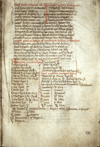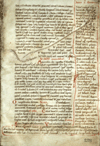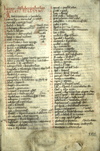

MS E 8 | View Catalog Record
This precious manuscript of 190 parchment leaves, written mainly in a steady Caroline minuscule, originated in England, perhaps in Hereford. Additions in later hands show that the volume remained in English libraries for at least five centuries. The original composition can be dated to around 1145, because it includes a list of twelve popes in which the eleventh entry, for Lucius II (1144-1145), is followed by a near-contemporary note on Eugenius III (1145-1153). The manuscript consists of more than forty widely varying texts. They cover the spectrum of medical learning as it was defined in the Middle Ages and illustrate a pivotal moment in the history of medicine.
The core treatise is the Hippocratic Aphorisms, the trunk from which sprang the theoretical and practical branches of the "Art of Medicine." Theory is represented, albeit sketchily, by anatomy, here primarily the conceptual "division of the body"; physiology, constructed around humors and temperaments; and nosology, with an inventory of diseases and their causes. Practical medicine figures more prominently in texts on diagnosis, particularly on reading pulses and urine; prognosis, in the Hippocratic tradition as well as by astrology and divination; and therapeutics, with several synopses for quick reference. Treatment branches out into dietary advice; plasters and other remedies, for afflictions ranging from migraine to snake bite; magical cures, remarkably few; herbals, glossaries of medicinal substances, and tables of weights and measures; and, ultimately, manual intervention by bloodletting and surgery.
The manuscript vividly documents an intermediate stage in the development of learned medicine. Though it is less exclusively utilitarian than early Latin antidotaries or Anglo-Saxon leechbooks, its theoretical passages barely intimate the growing interest in speculation. Much attention is devoted to the virtues of simples and compounds, without the proliferation of substances that characterizes subsequent polypharmacy. The principal sources, including the Aphorisms with a commentary, are translated directly from Greek to Latin; at the same time, writings by Isaac Israeli (d. 932) and Constantine the African (d. 1087) presage the coming influx of translations from Arabic. The two authors most visible in the collection, Oribasius (fourth century) and Alexander of Tralles (sixth century), are Byzantines. Their fading reputations were soon to be eclipsed by the authority of Galen, which is still in the background here. Mentions of Constantine, who became a Benedictine monk at Monte Cassino, and John Scarpellus "the Salernitan" (otherwise unknown) leave no doubt about southern Italian influences, yet there is no sign of the philosophical questions which were being discussed at the School of Salerno. Four of the texts correspond with works which the Salernitan masters were incorporating into a nuclear curriculum, later known in universities as Ars medicine or Articella. Interlinear and marginal notes foreshadow the Scholastic methods of gloss and commentary. Nevertheless, the volume seems designed for consultation rather than teaching. An ecclesiastical provenance may be suggested by the presence, at the end, of hymns with musical notations and of miracle stories. The majority of texts, however, evoke a practitioner guided by a rather autonomous medical tradition. In fine, the compilation typifies both a time of transition, from the early to the high Middle Ages, and an intermediate milieu, between the monastic infirmary and the faculty of medicine. The manuscript offers a cornucopia of subjects for further study.

The recipe attributed to Johannes Scarpelus Salernitanus indicates some degree of Salernitan influence in this manuscript.
Last Reviewed: June 13, 2024







![The hymn, 'Ave, maris stella, Dei mater' [Hail, Star of the Sea, Mother of God]. Folio 188 recto from Treatises on Medicine. NLM Unique ID: 100886418 The handwritten folio 188 recto from Treatises on Medicine. This folio is written in black ink with the hymn Ave, maris stella, Dei mater on the bottom half of the folio. In the bottom right corner in blue ink the number 188 has been stamped.](images/188.gif)